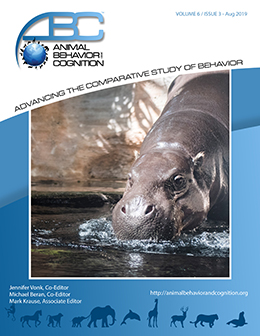Vol 6, Issue 3, August 2019
The Development of Sensorimotor Cognition in Common Ravens (Corvus corax) and its Comparative Evolution
Citation
Jacobs, I., Kabadayi, C., & Osvath, M. (2019). The development of sensorimotor cognition in common ravens (Corvus corax) and its comparative evolution. Animal Behavior and Cognition, 6(3), 194–212. https://doi.org/10.26451/abc.06.03.04.2019
Abstract
Evolution involves developmental change. Species comparisons play an important role in comparative cognition because they can uncover common patterns and shared principles in cognitive evolution. Developmental studies reveal foundational elements of cognitive abilities and how they are constructed and integrated. Sensorimotor cognition is such a key element that forms the foundation for later-developing cognitive skills, yet little is known about its development in animals. This study uses 37 behaviors and tasks to investigate the development of Piagetian sensorimotor abilities in five young ravens (Corvus corax) from ages two to eleven weeks. Their developmental pattern largely mirrored that of twelve other bird and mammal species, albeit at a markedly accelerated rate. They reached the final sensorimotor stage, which to date has been shown only in great apes. The onset and sequence of sensorimotor development was identical for all species. Absolute number of neurons in the pallium and rest of brain was associated with achieving a higher stage across these species. This was not the case for absolute or relative brain mass, or number of neurons in the cerebellum or whole brain. We discuss the independent evolution of sensorimotor cognition and the importance of developmental pace and pattern therein. These findings show that the study of sensorimotor development is a useful tool for comparative cognition research.
Keywords
Cognitive development, Sensorimotor cognition, Evolution of cognition, Heterochrony, Common raven
